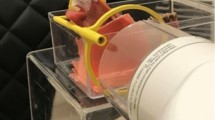Abstract
Objective
We present a novel method for intraoperative image-based bone surface reconstruction and its validation.
Materials and methods
In the preoperative stage, we construct a CT-like intensity atlas of the anatomy of interest. In the intraoperative stage, we deformably register this atlas to fluoroscopic X-ray images of the patient anatomy. We iteratively refine the atlas-to-patient registration by establishing explicit correspondences between bone surfaces in the atlas and their projections in the X-ray images. The advantage of our method is its use of CT-quality intensity data for correspondence establishment, which eliminates the edge-detection problem and diminishes the miscorrespondence problem. We validate our method on two datasets: (1) an in vitro dry femur; (2) Digitally Reconstructed Radiographs, which were generated from 17 clinical CTs, and simulate realistic in vivo femurs.
Results
The mean surface approximation error of our femur atlas was 0.85 ± 0.16 mm. On Digitally Reconstructed Radiographs, the mean surface reconstruction error was 1.40 ± 0.55 mm. On a dry femur, the mean surface reconstruction error was 1.44 mm.
Conclusion
The results show that our reconstruction method is on par with the state of the art in reconstruction of ex vivo femurs. In addition, the results demonstrate that our method is effective in realistic simulations of the in vivo scenario.
Similar content being viewed by others
References
Maintz J, Viergever M (1998) A survey of medical image registration. Med Image Anal 2(1): 1–37
Joskowicz L, Knaan D, Livyatan H, Yaniv Z, Khoury A, Mosheiff R, Liebergall M (2003) Anatomical image-based rigid registration between fluoroscopic X-ray and CT: methods comparison and experimental results. In: CARS, pp 419–425
Bansal R, Staib L, Chen Z, Rangarajan A, Knisely J, Nath R, Duncan J (2003) Entropy-based dual-portal-to-3-DCT registration incorporating pixel correlation. IEEE Trans Med Imag 22: 29–49
Sarrut D, Clippe S (2001) Geometrical transformation approximation for 2D/3D intensity-based registration of portal images and CT scan. In: MICCAI, pp 532–540
Bifulco P, Cesarelli M, Allen R, Sansone M, Bracale M (2001) Automatic recognition of vertebral landmarks in fluoroscopic sequences for analysis of intervertebral kinematics. Med Biol Eng Comput 39(1): 65–75
Benameur S, Mignotte M, Parent S, Labelle H, Skalli W, Guise JD (2003) 3D/2D registration and segmentation of scoliotic vertebrae using statistical models. Comput Med Imag Graph 27(5): 321–337
McLaughlin RA, Hipwell J, Hawkes DJ, Noble J, Byrne JV, Cox T (2002) A comparison of 2D–3D intensity-based registration and feature-based registration for neurointerventions. In: MICCAI, vol 2489/2002. Springer, Berlin, Heidelberg, pp 517–524
Tang TSY, Ellis RE (2005) 2D/3D deformable registration using a hybrid atlas. In: MICCAI (2), pp 223–230
Lamecker H, Wenckebach T, Hege HC (2006) Atlas-based 3D-shape reconstruction from X-ray images. Int Conf Pattern Recog (ICPR’) 2006(1): 371–374
Benameur S, Mignotte M, Labelle H, Guise JD (2005) A hierarchical statistical modeling approach for the unsupervised 3-D biplanar reconstruction of the scoliotic spine. IEEE Trans Biomed Eng 52(12): 2041–2057
Yao J, Taylor R (2003) Assessing accuracy factors in deformable 2D/3D medical image registration using a statistical pelvis model. In: Proc IEEE int conf comput vis (ICCV’03). IEEE Computer Society, Washington, DC, p 1329
Chintalapani G, Ellingsen LM, Sadowsky O, Prince JL, Taylor RH (2007) Statistical atlases of bone anatomy: construction, iterative improvement and validation. In: MICCAI (1), pp 499–506
Fleute M, Lavallée S (1999) Nonrigid 3D/2D registration of images using statistical models. In: MICCAI, pp 138–147
Zheng G, Dong X, Ballester MÁ G (2007) Unsupervised reconstruction of a patient-specific surface model of a proximal femur from calibrated fluoroscopic images. In: MICCAI (1), pp 834–841
Cootes TF, Edwards GJ, Taylor CJ (2003) Active appearance models. IEEE Trans Pattern Anal Mach Intell 23(6): 681–685
Matthews I, Baker S (2004) Active appearance models revisited. Int J Comput Vis (IJCV) 60(2): 135–164
Ibanez L, Schroeder W, Ng L, Cates J (2005) The ITK software guide, 2nd edn. Kitware, Inc. ISBN 1-930934-15-7. http://www.itk.org/ItkSoftwareGuide.pdf
Klein S, Staring M (2007) Elastix. Image Sciences Institute, University Medical Center Utrecht. http://www.isi.uu.nl/Elastix/
Rueckert D, Frangi AF, Schnabel JA (2001) Automatic construction of 3D statistical deformation models using non-rigid registration. In: MICCAI, London, UK. Springer, Heidelberg, pp 77–84
Si H (2006) TetGen: a quality tetrahedral mesh generator and three-dimensional delaunay triangulator. Weierstrass Institute for Applied Analysis and Stochastics, Berlin. http://tetgen.berlios.de/
Livyatan H, Yaniv Z, Joskowicz L (2002) Robust automatic C-arm calibration for fluoroscopic-based navigation: a practical approach. In: MICCAI, vol II, pp 60–68
Lemieux L, Jagoe R, Fish DR et al (1994) A patient-to-computed-tomography image registration method based on digitally reconstructed radiographs. Med Phys 21(11): 1749–1760
Penney G, Batchelor P, Hill D, Hawkes D, Weese J (2001) Validation of a two-to three-dimensional registration algorithm for aligning preoperative CT images and intraoperative fluoroscopy images. Med Phys 28(6): 1024–1032
Staring M, Klein S, Pluim J (2007) A rigidity penalty term for nonrigid registration. Med Phys 34(11): 4098–4108
Lewis RM, Torczon V (1999) Pattern search algorithms for bound constrained minimization. SIAM J Opt 9(4): 1082–1099
Marmitt G, Slusallek P (2006) Fast ray traversal of tetrahedral and hexahedral meshes for direct volume rendering. In: Ertl T, Joy KJ, Santos B (eds) Proc Eurographics/IEEE-VGTC Symp Visualization (EuroVIS’06), Lisbon, Portugal
Aspert N, Santa-Cruz D, Ebrahimi T (2002) Mesh: measuring errors between surfaces using the hausdorff distance. In: Proc IEEE int conf on multimedia and expo (ICME), vol I, pp 705–708. http://mesh.epfl.ch
Livyatan H, Yaniv Z, Joskowicz L (2003) Gradient-based 2D/3D rigid registration of fluoroscopic X-ray to CT. IEEE Trans Med Imag 22(11): 1395–1406
Fleute M, Lavallée S, Desbat L (2002) Integrated approach for matching statistical shape models with intra-operative 2D and 3D data. In: MICCAI (2), pp 364–372
Author information
Authors and Affiliations
Corresponding author
Rights and permissions
About this article
Cite this article
Hurvitz, A., Joskowicz, L. Registration of a CT-like atlas to fluoroscopic X-ray images using intensity correspondences. Int J CARS 3, 493–504 (2008). https://doi.org/10.1007/s11548-008-0264-z
Received:
Accepted:
Published:
Issue Date:
DOI: https://doi.org/10.1007/s11548-008-0264-z




